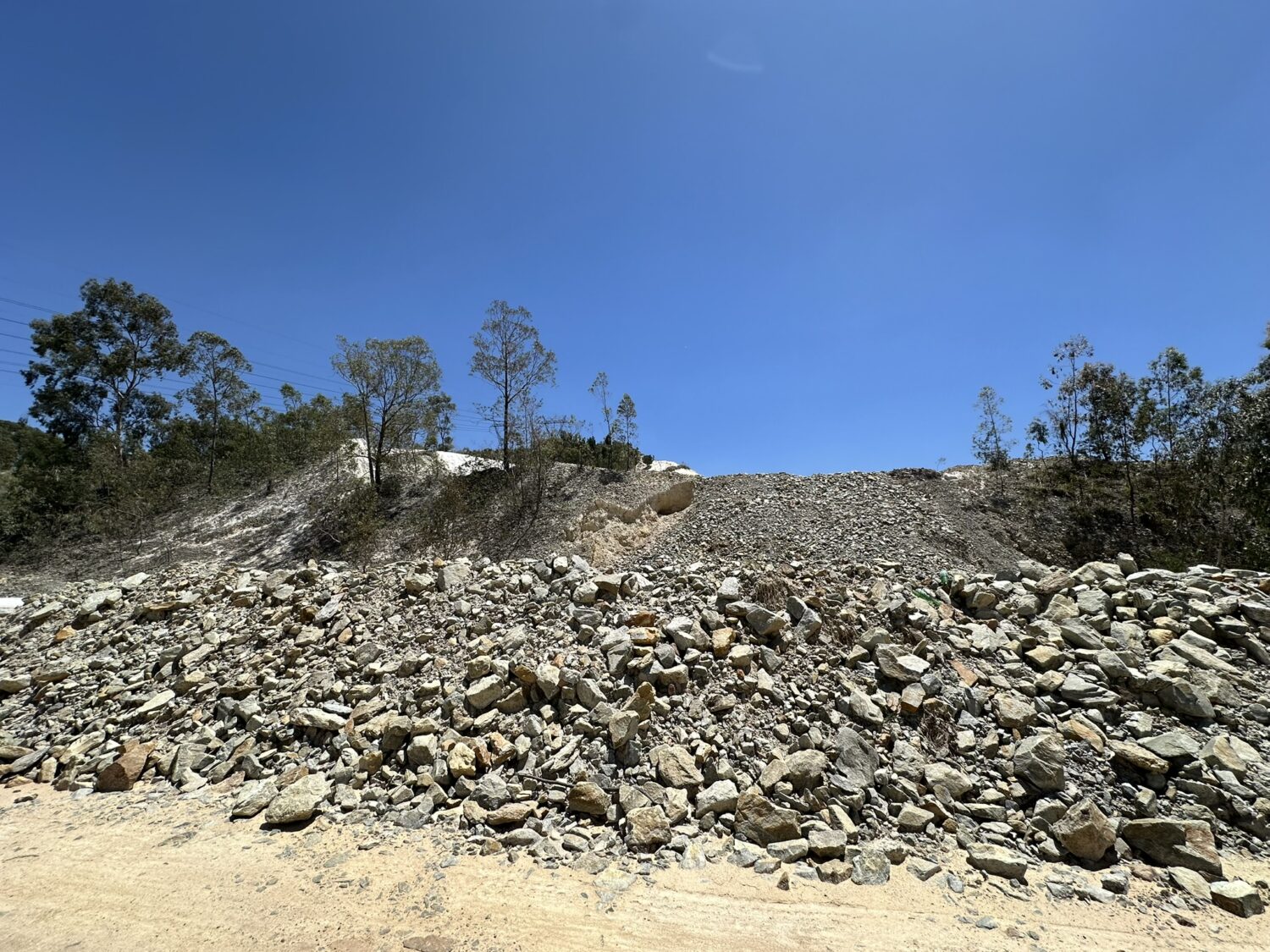Home » Insight » A site visit and evaluation of tailings ponds in South Africa’s Witwatersrand Basin
Introduction
Tailings dams or tailings storage facilities (TSFs[1]) contain the sand to clay-like waste products of mining. They are stored in tailings dams, which often reach heights of 100 metres or more[2]. Due to their composition of mining waste products, they can contain environmentally harmful elements and heavy metals such as lead, arsenic, mercury or antimony and require detailed knowledge of rock and soil mechanics for their construction, otherwise they can collapse (especially in the case of high-water saturation). Dam failures have led to serious accidents in the past (e.g. the collapse of the Brumadinho Dam of the mining company Vale in Brazil[3]).
To better understand the hazards that can arise from the construction of tailings ponds, the ERI ESG team went on a fact-finding mission to the world’s largest gold deposit, the Witwatersrand Basin in South Africa, west of Johannesburg.
In February 2024, we contacted Mariette Liefferink, environmental activist and CEO of the Federation for Sustainable Environment (FSE) and accepted an invitation for an environmental site visit to the Witwatersrand Basin, west of Johannesburg. The three-billion-year-old Witwatersrand Basin contains the largest known gold accumulation on earth as well as significant uranium deposits and has been an area of extensive mining activity for over a century. Together with stakeholders from various sectors (NGOs, scientists and representatives of mining companies), we visited facilities related to the storage of mine waste. The aim of the visit was to understand the impact of TSFs on the surrounding communities and the environment, to learn about solutions and measures taken by mining companies to address the problem and to familiarise ourselves with the challenges and views of different stakeholder groups. This helps us to carry out a competent sustainability assessment of mining companies, taking into account all relevant aspects, and to enter into a critical and constructive dialogue with the companies. The insights gained also helped to refine the ESG analysis for the Earth Sustainable Resources Fund.
South Africa and the mining industry
The mining sector is the economic backbone of South Africa and, as an important employer, contributes to improving the living conditions of people in South Africa. However, the economic and social benefits that mining brings to the country are also associated with negative effects on the environment and the population. While for a long time there were no comprehensive environmental regulations for South African mining, this has changed significantly in recent years and the industry has to comply with a complex set of mining and environmental legislation. This includes dealing with contaminated sites and responsibility for the impact of mine waste.
What are TSFs?
Mine tailings consist of ground rock and process wastewater produced in a processing plant. Mechanical and chemical processes are used to extract the desired metal (e.g. gold, uranium, platinum) from the mined ore, producing a slurry known as tailings (i.e. it comes out at the end of the extraction process). In the metal extraction process, it is not possible to recover all reusable and spent processing reagents and chemicals. The unrecoverable and uneconomical metals, minerals, chemicals, organics and process water are discharged as sludge into a tailings storage facility (TSF)[4]. Over time, such TSFs can grow to over 100 metres in height as new material is added from the extraction process. If TSFs are poorly designed, constructed or maintained, they can pose a significant risk to local communities and the environment.
The isolation of TSFs from groundwater is particularly critical. If TSFs are not sealed or vegetated, for example, this leads to people living nearby potentially being exposed to inhalable pollutants or groundwater contamination. The problem is exacerbated by the fact that mining is often located in weak areas of infrastructure with high unemployment, which is why people in search of a livelihood settle in mining areas and also engage in illegal mining in the vicinity. Housing estates, food crops and livestock grazing pose a high risk when utilising TSF areas or their zones of influence. A high level of safety is therefore crucial for responsible tailings management in order to minimise damage to people and the environment.
Figure 1: Example of a TSF. The water-rich sludge (end product of ore processing) is stored in ponds on stockpiles and separated by dams.
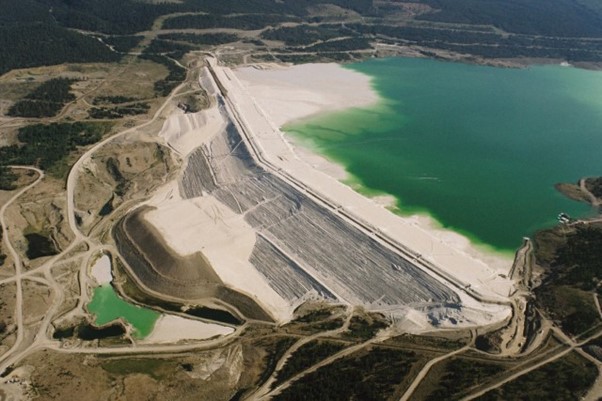
Source: Skycatch, https://blog.skycatch.com/extracting-useable-minerals-from-mining-waste-in-tailings-dams, 2021
Risk for people and nature
We were able to see an example of poor TSF management at dump 1L8 in the upper reaches of the Wonderfonteinspruit river (Fig. 2). Here, the former operator of the mine had shirked its obligation to properly rehabilitate the mine land by liquidating the mining company shortly before its closure and evading responsibility for environmental compliance and rehabilitation (due to inadequate funding of the rehabilitation fund). The problem of remediation was thus transferred to the taxpayer and the mining company that bought the mine. The area is currently largely uncultivated, which leads to environmental problems in the region. Due to the lack of fencing in the affected region, illegal mining is made possible there.
Figure 2: 1L8 Tailings Storage Facility. This example was used to explain the risks and causes for the failure of TSFs. The image shows a dam failure with loose material.

Source: Earth Resource Investments
Figure 3: Visit to the Lancaster Dam. Mariette Liefferink explains to the group that polluted water from old mining areas flowed into the Wonderfonteinspruit River and the Lancaster Dam, creating acidic water. The mining company tried to dig trenches (left in the image) to separate clean rainwater from the polluted water. Nevertheless, this water crosses a polluted area, becomes contaminated and flows past the dam, defeating its purpose.
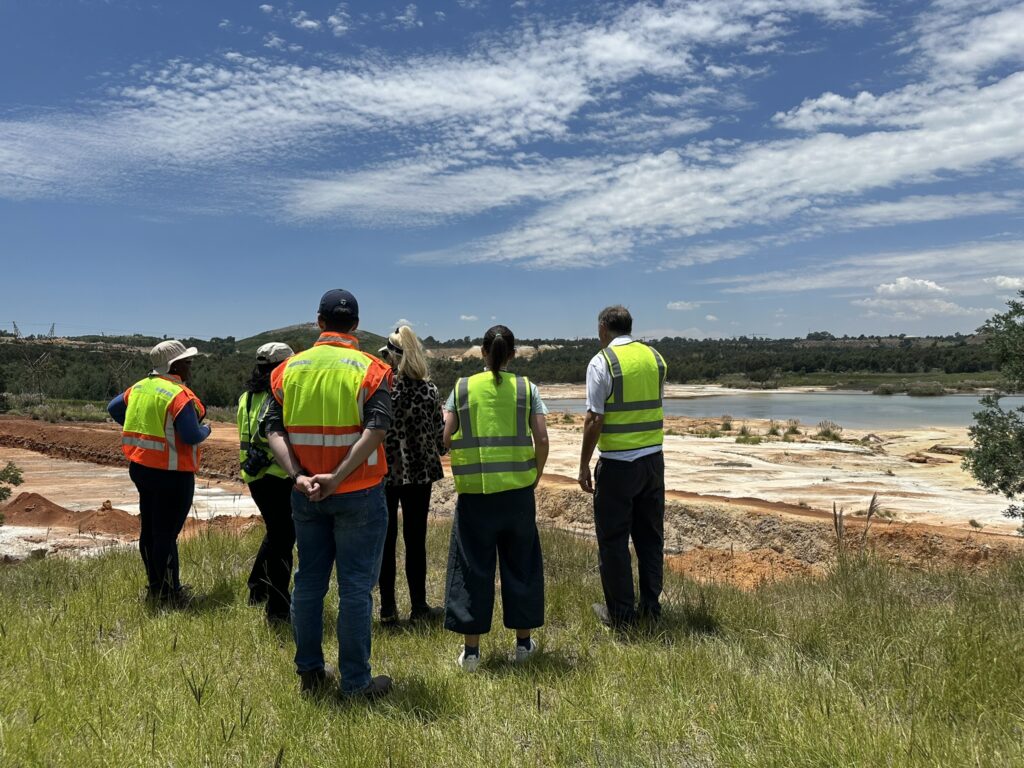
Source: Earth Resource Investments
Difficult remediation
After visiting the Lancaster Dam we visited the reclaimed Sand Dump 20 (Figure 4). At the time, it was the largest man-made sand dump in the world and a source of dust and water pollution. Sand Dump 20 was rehabilitated by Sibanye Stillwater (a South African mining company) and its predecessors in an exemplary manner and in accordance with the latest environmental regulations. The sand dump has now been almost completely removed by Sibanye Stillwater and parts of the site are being rehabilitated and reutilised.
Figure 4: Tour of the site of the reclaimed and now cleared Sand Dump 20 at Sibanye-Stillwater.
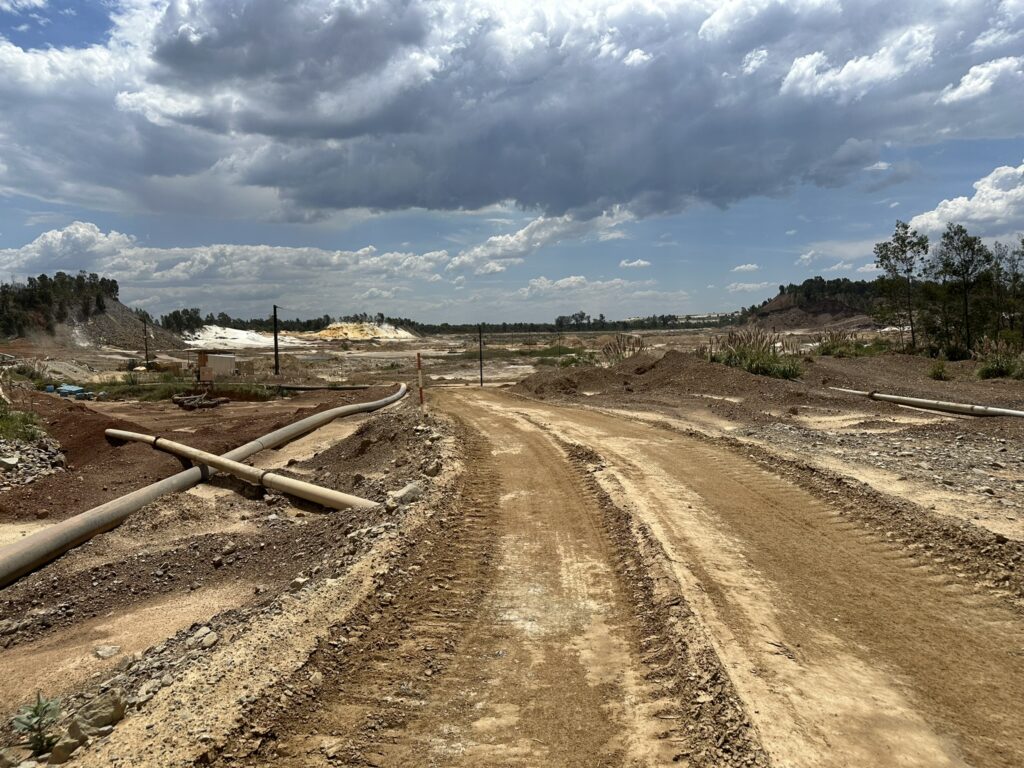
Source: Earth Resource Investments
Decades of mining in the Witwatersrand Basin have resulted in an extensive underground tunnel system that is continuously filled with water. As this water comes into contact with sulphide-containing minerals, it develops into acid mine water. In order to stop the run-off and possible contamination, three treatment plants were installed (Fig. 5) to remove the metals from the water and neutralise the acids produced by mining. However, the use of the treatment plants is a short-term solution; a longer-term solution is currently being investigated.
Figure 5: Tour of the Western Basin Acid Mine Drainage Treatment Plant.
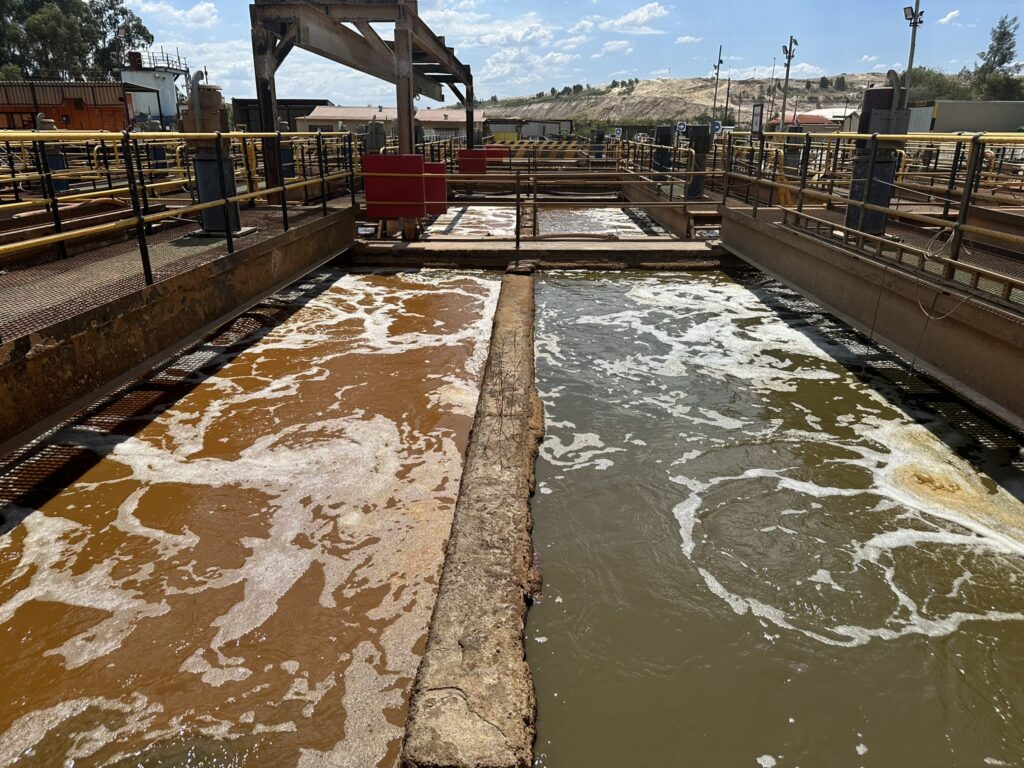
Source: Earth Resource Investments
Responsible transformation
At the end of our tour, we had the opportunity to visit an exemplary TSF at the Gold Fields South Deep Mine Doornpoort TSF (Fig. 6). The South Deep Mine is a modern mine with safe, highly mechanised mining operations. This also includes the clean and safe maintenance of the TSFs.
The Doornpoort TSF covers an area of around 460 hectares with a storage capacity of 205 million tonnes of material. This means that the South Deep Mine has enough space to store overburden for the rest of its life (80 years). Gold Fields has set itself the goal of adapting its TSFs to the requirements of the Global Industry Standard on Tailings Management (GISTM) by 2025. Developed by a multi-stakeholder panel, the GISTM is the first global standard for tailings management that aims to improve the safety of TSFs around the world by incorporating social, environmental, economic and technical considerations. It represents an important step towards transparency, accountability and respect for the rights of project-affected people.
Figure 6: The project visitors with representatives of Gold Fields at the exemplary designed Doornpoort TSF with ERI ESG team Pereshia Berlenbach and Ulrike Braun (3rd and 4th from right)

Conclusion
During our project visit, we were only able to visit a few TSFs of the Witwaterrand Basin mines, but we gained a deep insight into the different standards and approaches that mining companies take when operating TSFs, as well as their impact on the ecosystem and the people affected by mining. The challenges faced by mining companies are great, especially considering the large number of such legacy sites. Therefore, mining companies have a responsibility to ensure the safe and effective management of TSF risks at all stages of the mine life cycle and with the involvement of affected communities.
Standards such as the GISTM can create transparency and support the industry in its endeavours. However, there is also a need for leading and responsible companies that implement good practices and drive change in the industry. These companies need to be identified and supported through investment. Ultimately, the important insights gained on this mining trip helped to refine the ESG analysis technique for the Earth Sustainable Resources Fund and increase confidence in our ESG analyses. The mine visits to the Witwatersrand Basin also confirmed that competent ESG analysis can only be conducted with direct engagement with the mining companies.
[1] The term “Tailings Storage Facility” (TSF) is used throughout this article.
[2] Tailing Dams explained
[3] Brumadinho Dam Collapse
[4] Tailings explained

